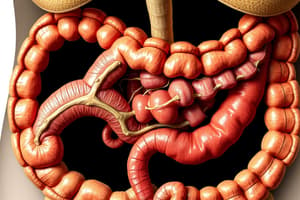Podcast
Questions and Answers
What is the main function of the sphincters in the alimentary canal?
What is the main function of the sphincters in the alimentary canal?
- To facilitate waste elimination
- To aid in taste reception
- To produce digestive enzymes
- To guard the entrance of the alimentary canal (correct)
Which part of the alimentary canal is responsible for food reception and contains organs for feeding and swallowing?
Which part of the alimentary canal is responsible for food reception and contains organs for feeding and swallowing?
- Hindgut
- Midgut
- Headgut (correct)
- Foregut
What is the function of the endocytosis process in nutrition and digestion physiology?
What is the function of the endocytosis process in nutrition and digestion physiology?
- To absorb nutrients through exterior body surfaces (correct)
- To seize prey
- To filter feed
- To digest food externally
Which cells of the alimentary canal are responsible for secreting enzymes and acids for digestion?
Which cells of the alimentary canal are responsible for secreting enzymes and acids for digestion?
What kind of treatment do nutrients receive in the alimentary canal before absorption?
What kind of treatment do nutrients receive in the alimentary canal before absorption?
In taste reception mechanisms, which type of cells release a neurotransmitter at a synapse modulating action potential production?
In taste reception mechanisms, which type of cells release a neurotransmitter at a synapse modulating action potential production?
Which type of mammal has a four-chambered stomach for cellulose digestion?
Which type of mammal has a four-chambered stomach for cellulose digestion?
What is the function of parietal cells in the lining of the monogastric stomach?
What is the function of parietal cells in the lining of the monogastric stomach?
Which type of fermenters have a longer and more complex digestive tract compared to carnivores?
Which type of fermenters have a longer and more complex digestive tract compared to carnivores?
What is the primary function of the omasum in the multi-chambered digastric stomach?
What is the primary function of the omasum in the multi-chambered digastric stomach?
What is the main role of prokaryotes and protists in the rumen and reticulum of ruminant mammals?
What is the main role of prokaryotes and protists in the rumen and reticulum of ruminant mammals?
How do hindgut fermenters like horses and elephants differ from foregut fermenters like deer and cattle?
How do hindgut fermenters like horses and elephants differ from foregut fermenters like deer and cattle?
What is the purpose of the design of the alimentary canal in animals?
What is the purpose of the design of the alimentary canal in animals?
Which type of animals are classified as foregut and hindgut fermenters?
Which type of animals are classified as foregut and hindgut fermenters?
What is one of the functions of saliva in digestion?
What is one of the functions of saliva in digestion?
How do humans produce saliva according to the text?
How do humans produce saliva according to the text?
Which best describes the formation of saliva in mammalian salivary glands?
Which best describes the formation of saliva in mammalian salivary glands?
What did Russian physiologist Ivan Pavlov study that led to a Nobel Prize in 1904?
What did Russian physiologist Ivan Pavlov study that led to a Nobel Prize in 1904?
Flashcards are hidden until you start studying
Study Notes
Gastric Stomach Features
- The monogastric stomach has a gastric pit, goblet cells that produce mucus, and gastric glands with parietal cells that secrete HCl and chief cells that secrete pepsinogen.
Ruminant Mammals Digestive System
- Ruminant mammals have a four-chambered stomach for cellulose digestion, with prokaryotes and protists in the rumen and reticulum breaking down cellulose.
- The animal periodically regurgitates the meal to soften the material (cud).
Multi-chambered Digastric Stomach
- Found in herbivores like deer, giraffes, and cattle, with symbiotic organisms carrying out fermentation in the rumen.
- Food is regurgitated and chewed again, producing ~1L gas/min, with the products of fermentation absorbed into the bloodstream.
- The four-chambered stomach has two divisions: rumen & reticulum, and omasum & abomasum (true stomach), with only the abomasum secreting enzymes.
Hindgut Fermenters vs Foregut Fermenters
- Hindgut fermenters include horses, elephants, and rabbits, with microorganisms in the cecum helping break down cellulose into sugars.
- Foregut fermenters include ruminants like deer, cattle, and camels.
Digestive System Adaptations
- Herbivores have longer and more complex digestive tracts than carnivores.
- The koala has a long (2m) cecum, where microorganisms help break down cellulose.
Feeding Methods
- Animals obtain and digest food in many different ways, including absorption through the body surface, endocytosis, filter feeding, sucking, biting, and using toxins.
Nutrition and Digestion Physiology
- Gastrointestinal secretions include salivary glands, secretory cells in the stomach, intestinal epithelium, and liver and pancreas.
- Food absorption occurs through the exterior body surfaces, endocytosis, and absorption through the gut wall.
Taste Reception
- Taste receptors are epithelial cells that release a neurotransmitter at a synapse, modulating action potential production in an afferent neuron.
- Five different taste sensations exist: sweet, salt, sour, bitter, and umami.
- Taste receptors interact with molecules through membranes to produce distinct tastes.
Saliva Functions and Flow
- Saliva is a complex mixture that allows food to be tasted, has antibacterial action, and initiates digestion of carbohydrates.
- Humans produce ~1L/day of saliva, with flow varying according to circadian rhythm.
- Dehydration and stress reduce flow, leading to dry mouth.
Studying That Suits You
Use AI to generate personalized quizzes and flashcards to suit your learning preferences.




